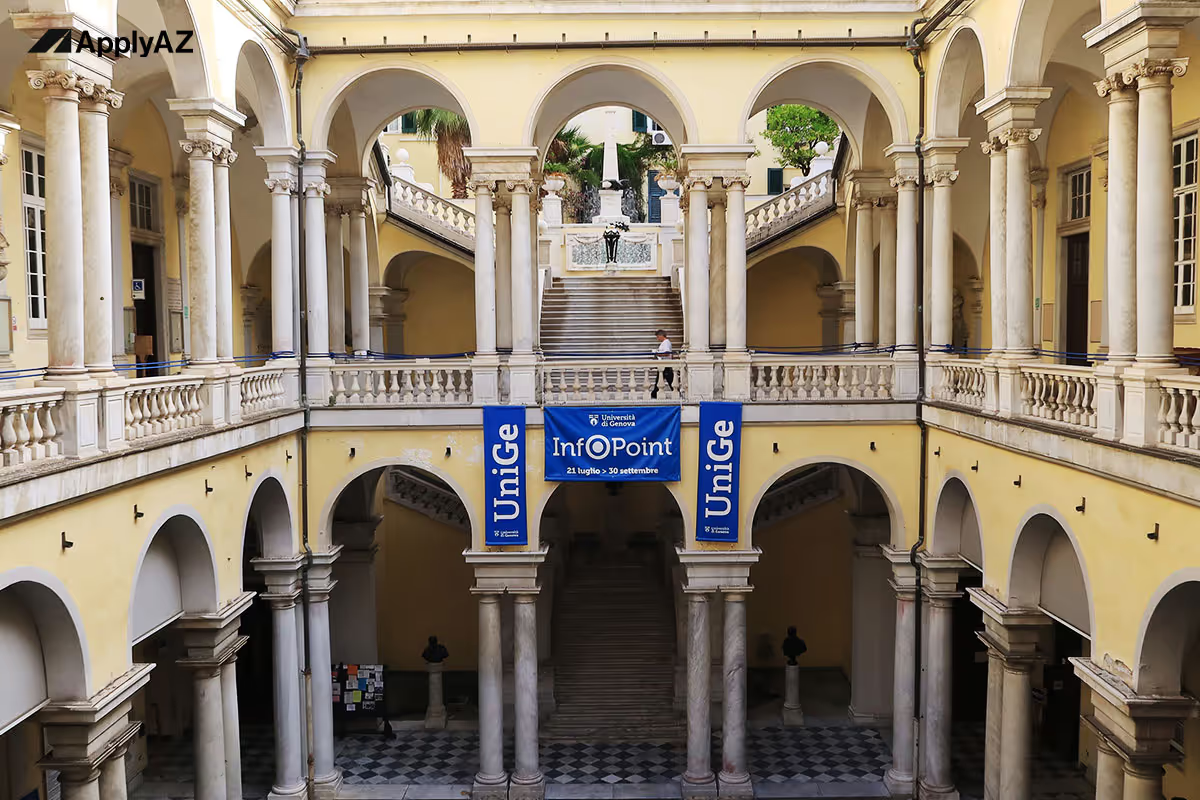Heading
Heading








University of Genoa
English‑taught programmes in Italy: why choose the University of Genoa
Founded in 1481 and consistently ranked among Europe’s leading maritime and engineering hubs, the University of Genoa offers more than 40 degree tracks taught partly or fully in English. This makes it one of the most versatile options for students seeking English‑taught programs in Italy while paying the regulated fees of public Italian universities. Incomes under specific thresholds can unlock the DSU grant, bringing total costs close to the levels often associated with tuition‑free universities Italy commentators mention. Key departments include naval architecture, robotics, computer science, biotechnology, and economics—each anchored by research centres that attract EU Horizon funding and private‑sector contracts.
Living and learning in a historic port city
Genoa stretches between mountains and sea, giving students a mild climate—winter averages 10 °C and summers hover around 28 °C. Shared flats in neighbourhoods like San Fruttuoso or Albaro cost roughly €300–€350 per month, and a €25 student travel pass covers buses, funiculars, and seaside trains. Cafeteria meals drop to €4 or even zero when the DSU grant applies. Cultural life blends Renaissance palaces, street‑art lanes, and open‑air concerts on the harbour. University sports clubs organise sailing, climbing, and coastal hikes, while language‑exchange cafés help you practise Italian after lectures.
Careers, internships, and industry links
Genoa is Europe’s busiest Mediterranean port and the core of Italy’s “Blue Economy.” Maritime giants, shipyards, and logistics groups recruit engineering and business students for roles in vessel design, supply‑chain analytics, and environmental compliance. The city also hosts the Italian Institute of Technology, famous for humanoid robots and smart materials—ideal for internships in AI, neuroscience, or nanotech. Biomedical start‑ups cluster around the university hospital, offering traineeships in gene therapy and medical imaging. Tourism and yachting sectors create seasonal part‑time jobs, useful for earning while studying. Career Services run bilingual CV workshops and link graduates to Erasmus+ traineeships across the EU.
Funding and academic support
Tuition scales from about €600 to €2 500 per year, depending on family income. Scholarships for international students in Italy include merit awards for high GPAs, fee waivers for refugee status, and lab assistantships that pay hourly. The DSU grant can waive tuition entirely, provide free meals, and contribute up to €7 000 toward rent and books—renewable when you pass 30 ECTS each year. The International Student Office helps with visa paperwork, health insurance, and accommodation lists, while the Language Centre offers free Italian courses from A1 to C1.
An inviting mix of heritage and innovation
Studying in Genoa means analysing wave mechanics in class and watching cargo ships glide past medieval city walls after hours. It means prototyping underwater drones in cutting‑edge labs, then testing them in the Ligurian Sea. Most of all, it means joining a diverse student body that values both tradition and forward‑thinking research. Choose Genoa if you want the networking ease of a medium‑sized city, the research muscle of a centuries‑old university, and cost structures that remain manageable thanks to Italy’s public‑education model and the DSU grant.
Ready for this programme?
If you qualify and we still have a spot this month, we’ll reserve your place with ApplyAZ. Our team will tailor a set of best-fit majors—including this course—and handle every form and deadline for you. One upload, many applications, guaranteed offers, DSU grant support, and visa coaching: that’s the ApplyAZ promise. Start now and secure your spot before this month’s intake fills up.
Master in Material Science and Technology (LM Sc. Mat.)
1. Why this master leads English‑taught programs in Italy
Choosing among English‑taught programs in Italy can feel overwhelming. This Material Science and Technology pathway helps you study in Italy in English while paying the regulated fees that apply to public Italian universities. With the DSU grant, many learners spend amounts similar to those discussed for tuition‑free universities Italy commentators mention. The course blends solid‑state physics, polymer chemistry, and surface engineering with entrepreneurship modules, producing graduates ready for research labs or advanced manufacturing floors.
2. Degree vision: materials for a sustainable future
From flexible solar cells to lightweight composites, advanced materials drive the green transition and digital society. This LM Sc. Mat. programme trains you to design, synthesise, and characterise such materials, then scale them to pilot production. You will:
- Model atomic and mesoscale structures that dictate mechanical, electronic, and optical properties.
- Synthesise polymers, ceramics, and metal alloys in glove‑box and high‑temperature furnaces.
- Use spectroscopy, microscopy, and diffraction to reveal structure–property relationships.
- Apply life‑cycle assessment to compare material footprints, aligning with EU circular‑economy goals.
- Collaborate with electrical, biomedical, and civil engineers on multifunctional products.
3. Curriculum overview: 120 ECTS over four semesters
3.1 Semester 1 – foundations and lab immersion
- Advanced Solid‑State Physics (8 ECTS) – band theory, phonons, defects; density‑functional homework builds a silicon band‐structure plot.
- Polymer Chemistry and Physics (8 ECTS) – step‑growth and chain‑growth kinetics, crystallinity, viscoelasticity.
- Materials Characterisation Techniques (6 ECTS) – XRD, SEM/TEM, AFM; weekly lab shifts analyse real samples.
- Thermodynamics and Phase Diagrams (6 ECTS) – Gibbs energy, phase equilibria, Calphad simulation.
- Scientific Communication (2 ECTS) – abstracts, figures, peer review.
3.2 Semester 2 – functional materials and modelling
- Electronic and Magnetic Materials (8 ECTS) – semiconductors, multiferroics, spintronics; clean‑room visit shows thin‑film deposition.
- Surface and Interface Engineering (6 ECTS) – plasma treatments, self‑assembled monolayers, adhesion mechanics.
- Numerical Methods for Materials Science (6 ECTS) – finite‑element stress analysis, molecular dynamics, Python scripting.
- Green Chemistry for Sustainable Materials (4 ECTS) – solvent‑free routes, biomass feedstocks, toxicology.
- Elective A (4 ECTS) – choose Energy Storage Materials, Biomaterials, or Smart Textiles.
3.3 Semester 3 – integration and innovation
- Composite and Hybrid Materials (6 ECTS) – fibre architectures, matrix selection, fracture toughness; vacuum infusion workshop.
- Nanomaterials and Quantum Dots (6 ECTS) – wet chemistry synthesis, size‑dependent properties, bio‑labelling.
- Materials for Additive Manufacturing (6 ECTS) – powder metallurgy, photopolymers, design for 3‑D printing; students print lattice cubes.
- Entrepreneurship and Tech Transfer (4 ECTS) – market validation, IP strategy, spin‑off funding.
- Innovation Lab (6 ECTS) – teams prototype a bio‑based coating or printed flexible sensor and pitch to industry panel.
- Elective B (4 ECTS) – options include Photonic Crystals, Corrosion Engineering, or Data‑driven Materials Discovery.
3.4 Semester 4 – internship and thesis
- Professional Internship (14 ECTS) – 350 hours minimum in R&D departments of polymer plants, nanotech start‑ups, or EU labs.
- Master’s Thesis (16 ECTS) – original research. Current topics: “Graphene‑reinforced epoxy for aerospace,” “Perovskite films via green solvents,” and “3‑D printed piezoelectric lattices.” Goal: SCI publication or patent application.
4. Facilities and digital resources
- Nanofabrication Clean‑Room – sputterers, ALD, e‑beam lithography, and glove‑box for perovskites.
- Spectroscopy Hub – FT‑IR, Raman, UV‑Vis‑NIR, time‑resolved photoluminescence.
- Electron Microscopy Suite – FE‑SEM, HR‑TEM, STEM‑EDS.
- Mechanical Testing Centre – universal testing machines, DMA, nano‑indenters.
- Additive Manufacturing Lab – SLS, FDM, SLA printers, and powder stage laser confocal.
- High‑Performance Computing Cluster – VASP, Quantum ESPRESSO, LAMMPS, and COMSOL licences.
Booking slots are online; instrument density (one SEM per 10 students) slashes wait times.
5. Research clusters and industry collaboration
University groups lead EU Horizon projects on:
- Recyclable thermosets for wind‑turbine blades.
- Stretchable conductors for wearable health monitors.
- Solid‑state hydrogen storage alloys.
- Geopolymer concretes for low‑carbon infrastructure.
Students can join as hourly paid research assistants, co‑authoring papers and attending conferences. Corporate partners—Solvay, Prysmian, Leonardo, and ENEL—fund scholarships, host internships, and deliver guest seminars on real production challenges.
6. Career pathways and professional credentials
6.1 Job roles
- R&D scientist in polymers, nanotech, or composites.
- Materials engineer in automotive, aerospace, or biomedical device firms.
- Quality and failure‑analysis specialist.
- Technical consultant on sustainability and LCA.
- PhD researcher in materials science, chemistry, or applied physics.
6.2 Certifications and standards
Course material prepares you for:
- Six Sigma Green Belt (process optimisation).
- NACE corrosion technologist exam.
- Chartered Engineer status within FEANI framework.
- NanoSafety cluster training for laboratory compliance.
Graduate surveys show 93 % employment or PhD enrolment within six months of graduation.
7. Funding: align costs with tuition‑free universities Italy headlines
Fee structure
Because the course belongs to public Italian universities, fees track family income: €900–€2 700 annually. Installments allow budgeting flexibility.
DSU grant
Qualifying students gain:
- Tuition waiver.
- Free or discounted meals.
- Housing allowance or dorm placement.
- Up to €7 000 cash stipend each year (30 ECTS required for renewal).
Other scholarships for international students in Italy
- Merit fee cuts (25 %) for GPA ≥ 3.5/4.0.
- Women in STEM bursaries (€3 000).
- Erasmus+ mobility grants to TU Delft, ETH Zürich, or DTU.
- Industry bursaries (€4 000) tied to green composites or solid‑state batteries.
Combined, these mechanisms lower net spending close to the levels often linked with tuition‑free universities Italy—while providing state‑of‑the‑art equipment and personalised mentorship.
8. Admission essentials and ApplyAZ support
- Bachelor’s degree (180 ECTS) in materials science, physics, chemistry, chemical engineering, or similar.
- Prerequisites – calculus, thermodynamics, basic solid‑state or polymer science.
- English certification – IELTS 6.5, TOEFL 90, or proof of English‑medium bachelor.
- Documents – transcript, CV, passport, motivation letter, two references.
- Portfolio (optional) – any published paper or project shows extra merit.
- Online interview – discuss an experiment, interpret an XRD pattern, outline career goals.
9. Learning culture: active projects, global peers
Classes flip theory videos with lab time; professors spend contact hours guiding problem‑solving, not reciting slides. Each five‑week cycle includes:
- Case dissection – review literature on a material failure or breakthrough.
- Hands‑on lab – replicate or extend the study using real equipment.
- Peer presentation – share findings in concise scientific format.
- Reflective critique – receive feedback and refine experimental design.
Cohorts blend learners from Europe, Asia, Africa, and the Americas, forging networks that outlive graduation.
10. Ten reasons to shortlist this LM Sc. Mat.
- Fully English‑taught while situated in a historic European research hub.
- Affordable fees of public Italian universities, plus DSU grant.
- Curriculum balances theory, synthesis, and product‑scale testing.
- Access to nanofabrication, spectroscopy, and additive‑manufacturing labs.
- EU‑funded projects offer paid research roles.
- Internships and thesis co‑supervision with global corporations.
- Electives that align with energy, biomedical, or data‑driven materials niches.
- Certification prep for Six Sigma, corrosion, and engineering charterships.
- Erasmus+ links to top technical universities for extra specialisation.
- Proven placement rates into industry R&D and PhD programmes worldwide.
Ready for this programme?
If you qualify and we still have a spot this month, we’ll reserve your place with ApplyAZ. Our team will tailor a set of best-fit majors—including this course—and handle every form and deadline for you. One upload, many applications, guaranteed offers, DSU grant support, and visa coaching: that’s the ApplyAZ promise. Start now and secure your spot before this month’s intake fills up.

They Began right where you are










